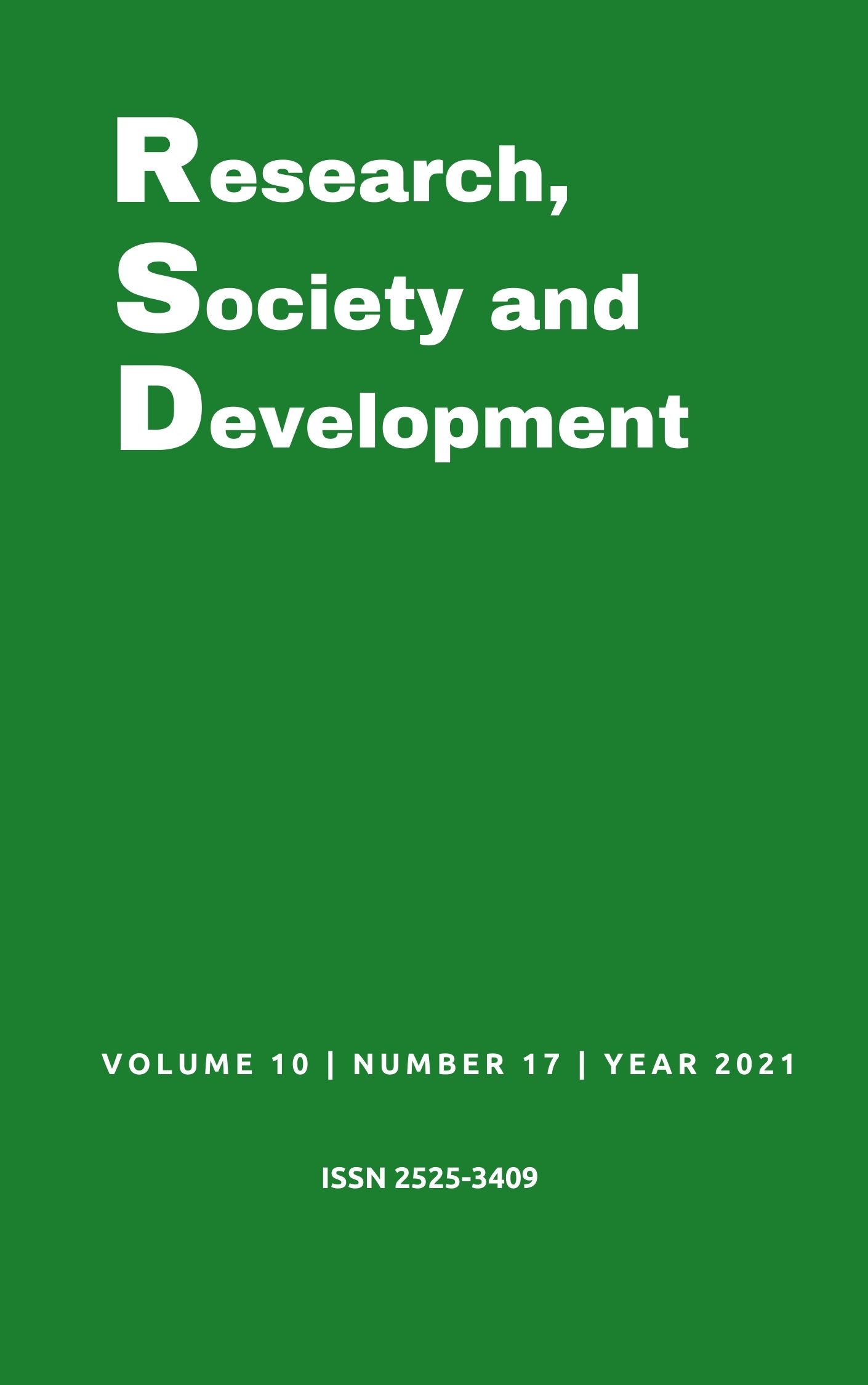Protocolo de scoping review: auriculoterapia em crianças e adolescentes no âmbito da Atenção à Saúde
DOI:
https://doi.org/10.33448/rsd-v10i17.24368Palavras-chave:
Adolescente, Atenção Integral à Saúde, Auriculoterapia, Criança.Resumo
O objetivo deste estudo é mapear e analisar a produção científica acerca da auriculoterapia para crianças e adolescentes no âmbito da atenção à saúde. Para tanto, foi utilizada a estratégia PCC: (P) Participantes – Crianças e Adolescentes entre 6 e 12 anos (OMS); (C) conceito: auriculoterapia; e (C) Contexto: atenção integral à saúde, como recomendam estudiosos (Aromataris & Munn, 2020) . Que originou a seguinte questão: Quais as evidências na literatura científica sobre auriculoterapia para crianças e adolescentes no âmbito da atenção integral à saúde? Esta revisão de escopo considerará estudos originais, realizados exclusivamente com seres humanos, crianças com idade entre 6 e 12 anos incompletos, publicados na íntegra em periódicos nacionais e internacionais, gratuitos ou não, com abordagem qualitativa e/ou quantitativa, nos idiomas português, inglês e espanhol. Os estudos deverão abordar o uso da auriculoterapia na atenção à saúde. Assim, serão considerados os estudos com as variações de recursos da auriculoterapia (sementes de vaccaria, esferas magnéticas e cristais). As fontes indexadas que serão utilizadas para a revisão de escopo são: Medical Literature Anallysis and Retrieval System online (MEDLINE); Literatura Latino-Americana e do Caribe em Ciências da Saúde (LILACS); Scientific Electronic Library online (SCIELO); as bases de dados Cochrane Database of Systematic Reviews (CDCR), a Bibliografia Brasileira de Odontologia (BBO), bem como a Biblioteca Virtual em Saúde em Medicinas Tradicionais, Complementar e Integrativa (BVS MTCI), Biblioteca Virtual em Saúde do Adolescente (ADOLEC) e Physiotherapy Evidence Database (PEDro). Para pesquisar a literatura cinzenta, será consultada a Coordenação de Aperfeiçoamento de Pessoal de Nível Superior (CAPES). As buscas nestas fontes indexadas serão realizadas no período entre fevereiro e março de 2022. Espera-se com esta revisão contribuir com o estado da arte acerca da produção e implementação de Práticas Integrativas Complementares.
Referências
Arkey, H., & O'Malley, L. (2005). Scoping Studies: Towards a Methodological Framework. International Journal of Social Research Methodology: Theory & Practice, 8(1), 19–32. doi:10.1080/1364557032000119616.
Aromataris, E. & Munn, Z. (2020). JBI Manual for Evidence Synthesis. JBI. doi:10.46658/JBIMES-20-01
Correa H.P., Moura C.C., Azevedo C., Bernardes, M.F.V.G., Mata, L.R.F.P., Chianca, T,C,M,.(2020). Effects of auriculotherapy on stress, anxiety and depression in adults and older adults: a systematic review. Revista da Escola de Enfermagem de USP. 54:e03626. doi:10.1590/S1980-220X2019006703626
Brasil (2012). Ministério da Saúde. Secretaria de Atenção à Saúde. Departamento de Atenção Básica. Saúde da criança: crescimento e desenvolvimento. Brasília: Ministério da Saúde, 1-272.
Brasil (2015). Ministério da Saúde. Secretaria de Atenção à Saúde. Departamento de Atenção Básica. Política Nacional de Práticas Integrativas e Complementares no SUS: atitude de ampliação de acesso. 2. ed. Brasília: Ministério da Saúde, 1-95.
Binesh, M., Daghighi, M.R., Shirazi, E., Oleson, T., Hashem-Dabagjian, F. (2020). Comparison of Auricular Therapy with Sham in Children with Attention Deficit/Hyperactivity Disorder: A Randomized Controlled Trial. J Altern Complement Med. Jun; 26(6), 515-520. doi:10.1089/acm.2019.0477.
Cordeiro, L. & Soares, C. B.(2019). Revisão de escopo: potencialidades para a síntese de metodologias utilizadas em pesquisa primária qualitativa. Boletim do Instituto de Saúde - BIS, São Paulo, 20, (2), 37-43. https://docs.bvsalud.org/biblioref/2019/10/1021863/bis-v20n2-sintese-de-evidencias-qualitativas-37-43.pdf.
Cha, H.S., Park, H.( 2019). Efeitos da acupressão auricular na obesidade em adolescentes. Complement Ther Clin Pract. Maio, (35), 316-322. doi: 10.1016 / j.ctcp.2019.03.014.
Esteriz Mesidoro, N., Taboada Torres, A., Aponte González, M., & Esteriz Mesidoro, Y. (2020). Auriculoterapia en pacientes con queratitis punteada superficial. MEDISAN, 24(3), 396-405. http://scielo.sld.cu/scielo.php?script=sci_arttext&pid=S1029-30192020000300396&lng=es&tlng=es.
Fonseca, W.P. (2011). Acupuntura Auricular Chinesa. São Paulo: Andreoli.
Gao, H., Zhang, L., Liu, J. (2020). Auricular acupressure for myopia in children and adolescents: A systematic review. Complement Ther Clin Pract. doi: 10.1016/j.ctcp.2019.101067.
Nielsen, A. Gereau, S., Tick, H. (2020). Risks and Safety of Extended Auricular Therapy: A Review of Reviews and Case Reports of Adverse Events. Pain Med. Jun 1; 21, (6), 1276-1293. doi: 10.1093/pm/pnz379.
Peters, M., Marnie, C., Tricco, A. C., Pollock, D., Munn, Z., Alexander, L., McInerney, P., Godfrey, C. M., & Khalil, H. (2020). Updated methodological guidance for the conduct of scoping reviews. JBI evidence synthesis, 18(10), 2119–2126. doi: 10.11124 / JBIES-20-00167
Ouzzani, M., Hammady, H., Fedorowicz, Z., Elmagarmid, A. (2106). Rayyan—a web and mobile app for systematic reviews. Syst Rev 5, 210. doi.org/10.1186/s13643-016-0384-4.
Tricco, A. C., Lillie, E., Zarin, W., O'Brien, K. K., Colquhoun, H., Levac, D., Moher, D., Peters, M. D., Horsley, T., Weeks, L., & Hempel, S., (2018). PRISMA extension for scoping reviews (PRISMA-ScR): checklist and explanation. Annals of internal medicine, 169(7), 467-473. doi: 10.7326 / M18-0850
Downloads
Publicado
Edição
Seção
Licença
Copyright (c) 2021 Karla Adriana Ferreira Beckman; Marimeire Morais da Conceição; Denízia Maria Barberino Xavier Santos; Márcia Aparecida Ferreira de Oliveira; Ana Maria Fernandes Pitta

Este trabalho está licenciado sob uma licença Creative Commons Attribution 4.0 International License.
Autores que publicam nesta revista concordam com os seguintes termos:
1) Autores mantém os direitos autorais e concedem à revista o direito de primeira publicação, com o trabalho simultaneamente licenciado sob a Licença Creative Commons Attribution que permite o compartilhamento do trabalho com reconhecimento da autoria e publicação inicial nesta revista.
2) Autores têm autorização para assumir contratos adicionais separadamente, para distribuição não-exclusiva da versão do trabalho publicada nesta revista (ex.: publicar em repositório institucional ou como capítulo de livro), com reconhecimento de autoria e publicação inicial nesta revista.
3) Autores têm permissão e são estimulados a publicar e distribuir seu trabalho online (ex.: em repositórios institucionais ou na sua página pessoal) a qualquer ponto antes ou durante o processo editorial, já que isso pode gerar alterações produtivas, bem como aumentar o impacto e a citação do trabalho publicado.


